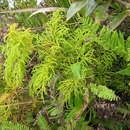ar
الأسماء في صفحات التنقل


Palhinhaea cernua, synonym Lycopodiella cernua and Lycopodium cernuum, is a plant in the family Lycopodiaceae,[2] commonly known as the staghorn clubmoss.[3] The Hawaiian name for the plant is wāwaeʻiole, or "rat's foot". It has a substantial number of scientific synonyms in several genera. The genus Palhinhaea is accepted in the Pteridophyte Phylogeny Group classification of 2016 (PPG I),[4] but not in other classifications which submerge the genus in Lycopodiella.[5] It is the largest of the clubmosses, having rhizomes up to 5 m (16 ft) in length, with leafy uprights up to 2.5 m (8 ft 2 in) in height.[6]
Palhinhaea cernua is a widespread pan-tropical species, found mostly at higher elevations in subtropical mountain climates of tropical Africa, Asia, the Pacific Islands and the Neotropics. In Europe, it is found in the Azores (where it is possibly native) and formerly on Madeira. It has been introduced in continental Portugal (Valongo), Sicily and Malta.[1]
It favors bog environments.
Palhinhaea cernua is sometimes cultivated.
{{cite journal}}: CS1 maint: multiple names: authors list (link) Palhinhaea cernua, synonym Lycopodiella cernua and Lycopodium cernuum, is a plant in the family Lycopodiaceae, commonly known as the staghorn clubmoss. The Hawaiian name for the plant is wāwaeʻiole, or "rat's foot". It has a substantial number of scientific synonyms in several genera. The genus Palhinhaea is accepted in the Pteridophyte Phylogeny Group classification of 2016 (PPG I), but not in other classifications which submerge the genus in Lycopodiella. It is the largest of the clubmosses, having rhizomes up to 5 m (16 ft) in length, with leafy uprights up to 2.5 m (8 ft 2 in) in height.
Lycopodiella cernua est une espèce de lycopodes de la famille des Lycopodiaceae. Présente dans la plupart des régions tropicales et subtropicales, cette espèce a une des répartitions géographiques les plus vastes de sa famille. Elle est parfois cultivée.
D'après des publications récentes (2014, 2015[3]), le nom correct à retenir pour désigner cette espèce est Palhinhaea cernua (L.) Vasc. & Franco, et le nom Lycopodiella cernua (L.) Pic. Serm. doit être considéré comme un synonyme nomenclatural.
Elle est connue en Guyane sous les noms de patte d'araignée [pat-arengnen], mâle verge [mal-verj] (créole guyanais), waraku awak (Palikur), lycopode (Français), palma-de-São-Ioão (brésilien)[4], ou dans le monde anglophone staghorn clubmoss[5] ou encore wāwaeʻiole (nourriture des rats) à Hawaï, 過山龍 à Taïwan, Thông đất au Vietnam.
Lycopodiella cernua est présente dans les savanes d'altitude aux Petites Antilles, sur les talus des pistes forestières et les radeaux de végétation flottante marécageuse de la région côtière en Guyane.
Elle affectionne les milieux tourbeux du sud des États-Unis, et de Hawaii.
On la rencontre également en Asie du Sud-Est[6], en Australie[7], en Europe du Sud (Sicile en Italie, aux Açores[8] et à Valongo au Portugal, en Espagne), en Afrique tropicale et du sud[9], à Madagascar et dans les Mascareignes, et du sud des États-Unis[10] à l'Amérique du Sud[11].
En Guyane, Lycopodiella cernua est utilisée pour éloigner les mauvais esprits chez les Créoles guyanais. Les émigrés javanais du Suriname fument cette plante sous forme de cigarette comme succédané du tabac (elle contient de la nicotine). Les Palikur l'emploient pour des bains fébrifuges, ou en décoction salée contre les envenimations d'araignées[4]. Elle est aussi utilisée pour agrémenter des bouquets floraux.
Selon Tropicos (27 mai 2017)[12] :
Lycopodiella cernua est une espèce de lycopodes de la famille des Lycopodiaceae. Présente dans la plupart des régions tropicales et subtropicales, cette espèce a une des répartitions géographiques les plus vastes de sa famille. Elle est parfois cultivée.
D'après des publications récentes (2014, 2015[3]), le nom correct à retenir pour désigner cette espèce est Palhinhaea cernua (L.) Vasc. & Franco, et le nom Lycopodiella cernua (L.) Pic. Serm. doit être considéré comme un synonyme nomenclatural.
Elle est connue en Guyane sous les noms de patte d'araignée [pat-arengnen], mâle verge [mal-verj] (créole guyanais), waraku awak (Palikur), lycopode (Français), palma-de-São-Ioão (brésilien), ou dans le monde anglophone staghorn clubmoss ou encore wāwaeʻiole (nourriture des rats) à Hawaï, 過山龍 à Taïwan, Thông đất au Vietnam.
Lycopodiella cernua adalah sejenis tumbuhan anggota suku Lycopodiaceae. Dalam literatur dikenal sebagai paku kawat. Penyebutan "paku" berdasarkan klasifikasi moderen sudah tidak tepat karena berdasarkan filogeni ia lebih dekat dengan tumbuhan lumut daripada tumbuhan paku sejati.
Penyebaran geografis tumbuhan ini luas terutama di kawasan tropis. Biasanya ditemui di tebing-tebing lembab agak berair. Pertumbuhannya kadang-kadang tidak terkendali dan menutupi area permukaan tanah.
Kumpulan paku kawat biasa dimanfaatkan sebagai tempat menancapkan karangan bunga hias.
Lycopodiella cernua adalah sejenis tumbuhan anggota suku Lycopodiaceae. Dalam literatur dikenal sebagai paku kawat. Penyebutan "paku" berdasarkan klasifikasi moderen sudah tidak tepat karena berdasarkan filogeni ia lebih dekat dengan tumbuhan lumut daripada tumbuhan paku sejati.
Penyebaran geografis tumbuhan ini luas terutama di kawasan tropis. Biasanya ditemui di tebing-tebing lembab agak berair. Pertumbuhannya kadang-kadang tidak terkendali dan menutupi area permukaan tanah.
Kumpulan paku kawat biasa dimanfaatkan sebagai tempat menancapkan karangan bunga hias.
Lycopodiella cernua é uma espécie de pteridófito pertencente à família Lycopodiaceae.[1]
Esta espécie apresenta a distribuição natural mais alargada entre todas as espécies da respectiva família, ocorrendo em praticamente todas as regiões tropicais e subtropicais, onde em geral ocorrem em zonas pantanosas.
Ocorre nas ilhas açorianas de São Miguel, Terceira, Pico e Faial onde é conhecida pelo nome comum de pinheirinho, musgão e musgo-do-mato.[2] Surge também na ilha da Madeira e em muitas regiões tropicais. Na Europa surge ainda na Sicília e em algumas regiões costeira da Península Ibérica.
Lycopodiella cernua é por vezes cultivada.
Lycopodiella cernua é uma espécie de pteridófito pertencente à família Lycopodiaceae.
垂穗石松(学名:Palhinhaea cernua)为石松科垂穗石松属下的一个种。